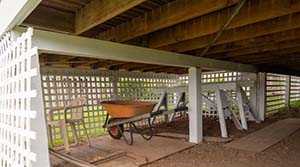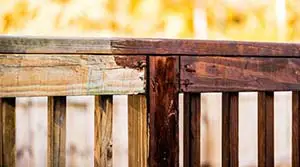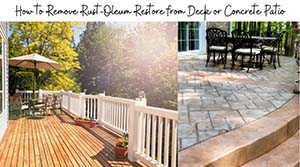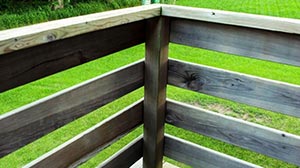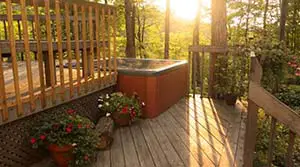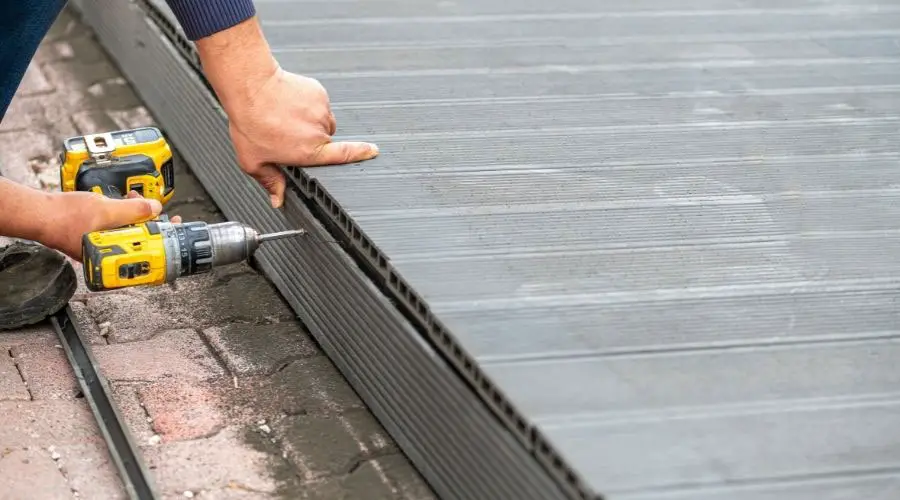
Composite decking is among the most efficient and most popular decking available on the market. If you compare it with wooden decking, which needs extensive maintenance and care to look sharp and stay clean, composite decking requires little cleaning or maintenance.
Composite decks are not high maintenance and are relatively easy to clean because it is engineered to repel dirt. Removing molds, mildews, and debris every time you see one will help maintain a clean look for your deck. You can use soap and water to clean your deck regularly.
But what makes composite decking easy to maintain? And how do you go about it? In this guide, I explored the best cleaning and maintenance tips for composite decks.
What Kind of Maintenance Does a Composite Deck Need?
It won’t hurt to spend at least 3 hours of your time cleaning the composite deck to keep it looking like new. It will safeguard your deck against potential problems in the future and ensure its durability.
Below is the preparation for the cleaning process:
- For those with organization skills, it will take you a few hours to complete everything. However, remember to do the task during summer when the deck is dry, and the water you add can evaporate quickly. It is essential to work in small sections, especially in direct sunlight. It prevents suds and dirty water from drying on your deck before you get a chance to wash it away. You can see an example of this in the video above.
- Another thing to keep in mind is to move the furniture that is on your deck. It includes potted plants, barbeque grills, chairs, and tables. Cleaning around the furniture is more complex than you could ever comprehend.
- Since the deck is covered in small gaps, this allows debris fall during the sweeping phase. If you allow the debris to accumulate, it’ll cause blockages that restrict rainwater from draining properly. Any standing water on the deck can make boards warp, crack, or swell.
Even though composite boards are more resistant to cracking and warping than traditional timber, they aren’t immune to damages from standing water. You should therefore clear the gas each time you clean the deck.
Ways to Clean Common Decking Issues
1. Mildew & Mold
Mold and mildew will not damage composite decks. Mold might look terrible on your deck, but it won’t ruin or harm the composite deck structure.
The best approach to remove them is by employing the soap-and-water approach. Ensure that you do a thorough cleaning.
2. General Debris
Debris is a pain to get rid of on your deck, especially when you have trees nearby! Small twigs, leaves, and other material always accumulate on the deck over time, even if it does not hurt your floor.
Still, these objects can provide a breeding ground for mold and mildew when it gets wet. It would help if you kept the deck clean by blowing or sweeping off the debris as necessary.
3. Dirt Between Floor Grooves
The small spaces and grooves between the deck sometimes trap grime and dirt over time. If the dirt builds up, you should clean using the soap-and-water approach.
If it doesn’t remove grime between the boards, you can use a pressure washer. Do the following to protect your deck as you wash it:
- Employ at most 1,500 PSI (or the PSI the manufacture has)
- Apply a fan tip
4. Beverage & Food Stains
A paper towel can easily remove food and drink stains. Removing it applies to the dreaded wine stains too.
If using a paper towel doesn’t help, you should use the soap-and-water approach. Cleaning drinks and food stains from a composite deck is relatively easy.
5. Grease & Oil
Whether you have a portable grill or outdoor kitchen, people prefer preparing food and cooking on their porch and deck. It means you might end up leaving grease and oil on the deck floor.
When you notice grease and oil on your deck, you should remove them immediately to avoid permanent staining. I recommend that you remove any stain from your deck within seven days.
To clean grease and oil from a composite deck, use soap and water. The earlier and quicker you do it, the more efficiently you’ll remove everything without leaving a stain.
6. Pollens
Depending on the plants closer to the deck, you might notice a thin coating of pollen on the deck. It would help if you didn’t worry since pollen doesn’t lead to long-term damage. However, you should remove it quickly.
To remove pollen effectively from the composite deck, you should power wash it. Ensure you employ the best power washing practices.
7. Ice & Snow
Ice and snow usually build up during winter. Here, it would be best if you employed tools that won’t destroy the deck surface. You can quickly shovel the snow off but make sure to use the right shovel. There are times when you might be forced to use a snowblower.
How Do I Keep My Composite Deck Clean?
Since your deck is exposed to different elements throughout the year, it would be best to create a routine upkeep plan to prevent expensive repairs.
Below is a deck maintenance schedule to help you out:
Springtime:
Wash Your Deck
Any unwashed composite deck will invite mildew and mold, thus causing rot. Ensure you do the following:
- Remove debris between the deck boards with a putty knife.
- Protect all paintings and shrubs. Wet the paintings and shrubs and cover them with plastic sheeting.
- Sweep your deck thoroughly.
- Select the cleanser that is meant for composite material. For instance, you should attack oil and grease using commercial detergents and degreasers.
- Clean your deck. Here, you can scrub the deck using a soft brush. Avoid using a pressure washer since it can destroy your deck and void its warranty. Remove leaf stains and rust using a deck brightener containing oxalic acid.
- Allow the deck to dry. It could take about two days before you seal it.
Seal Your Deck
Stains and sealers are sold at home improvement centers at $30 per gallon. It is enough to cover about 250 square feet of the deck surface.
The sealing options include:
- A clear sealer that allows the deck’s natural color and grain to show through.
- The toner will add some color but reveals the grain and offers some protection against UV light.
- A semi-transparent stain that tints your deck but still allows the grain to show.
- Opaque color and solid gran that completely covers the grain and seals weathering damage.
You should apply clear toner and sealers annually. Ensure you wear a safety mask, eye protection, and gloves while applying sealers and stains. Below are steps to sealing the deck:
- Select a two-day period when the temperatures will be moderate and the skies clear.
- Sand your deck lightly.
- Replace any popped or missing screws and nails.
- Apply the stain or sealers. Employ a roller to apply your sealer on the deck. Ensure you cover 3-4 boards at a time. Don’t allow the sealant to puddle or dry.
Midsummer:
Inspect & Repair the Deck
When the weather is warm, you should give your composite deck a thorough inspection. Pay closer attention to areas that are closer to water. Below are things to do:
- Look for any rot signs.
- Inspect the ledger using a flight light below the deck.
- Check the remaining posts, beams, and joists and replace them if they have rust.
- Check for any cracks or decking boards that have rotten. If there are any damages, replace the piece.
- Check the railing. Provide a good shake to ensure posts aren’t damaged or loose.
Fall:
Preventive Measures
If you didn’t have enough time to seal and wash the composite deck during spring, fall is the perfect time to do so. To have the deck in excellent shape:
- Trim the nearby trees and bushes. They should be at least 12-inches from the deck to prevent rot, moss, and mold.
- Don’t allow debris and leaves to pile in the corners.
- Move tables, chairs, and planters to avoid discoloring your deck. Nearby downspouts and gutters should always be in good shape.
Can You Use Washing Liquid On Composite Decking?
You can use a washing solution on your composite deck. A dishwashing liquid diluted with water works well when it comes to cleaning your deck. Manufacturers recommend that you use the solution if there’s persistent dirt or stains on the deck.
You can use the solution and a brush to scrub away dirt. This way, you’re guaranteed to have a durable deck.
You might be wondering what the best cleaners for your composite decking are? You can either go for a homemade solution or commercial cleaners.
Commercial Cleaning Products
There are several commercial cleaning solutions that you can consider on the market. To get the best product, consult a professional or the manufacturer. Commercial cleaning solutions are reputable for working effectively and ensuring quality cleanliness.
However, it would help if you were very careful when it comes to using commercial products. Most of these products have chemicals that might be harmful to children and pets. It would therefore help to avoid products that chlorine bleach.
You should also wear protective gear while applying commercial products. If you find the right cleaner, you’ll get the results you’re looking for.
Homemade Solutions
Homemade solutions are eco-friendly compared to commercial products. Here, you can use a dishwashing liquid, as we have seen above. You can also go for vinegar due to its effectiveness and safety.
Vinegar has acetic acid, which dissolves stains, grime, and dirt. It also kills bacteria on the deck surface. You can even pair vinegar with baking soda. After using vinegar, remember to rinse the surface with water.
How Often Should You Clean Composite Decking?
It would be best if you washed your composite deck at least twice per year. It will make the deck more durable and appealing.
However, clean it more often if it’s exposed to a moist and dusty environment. You should use a regular brush and cleaner to scrub off any stains.
If the deck is more oversized or scrubbing is ineffective, you can use a pressure washer. However, professionals recommend that you avoid using it where possible.
Mistakes to Avoid While Cleaning Your Deck
To improve on the effectiveness of your cleaning exercise, it would help to avoid inevitable common mistakes:
Using the Wrong Cleaner
Selecting the perfect cleaner for your job can either break or make your deck. Even though the composite deck surface looks solid, it’s pretty porous. Therefore, you’ll require an oxygenated cleaner that can get deep into the deck and clean both the inside and the surface.
While looking for a cleaner to purchase, always check its label and avoid using chlorine bleach. Any product that has Sodium Hypochlorite as an active ingredient contains bleach. Chlorine bleach is corrosive and can eat away your deck material slowly by slowly and eventually damage the surface.
Always go for non-toxic cleaners that contain Sodium Percarbonate.
Pressure Washing the Composite Deck
When it comes to cleaning composite decks, pressure washing isn’t recommended. It could translate into a considerable problem if done incorrectly.
If you pressure wash with a lot of pressure or too close to the deck, you can ruin the surface. This can be attributed to composite materials being softer and lighter than wood, therefore, being etched more easily. After the deck material is opened up, many other problems, including mold staining, chipping, and sun damage, could occur. When mold stains in a composite deck, it becomes difficult to remove.
In place of a pressure washer, you can use a garden hose pipe. If it’s a must to use a pressure washer, you should go for the lowest pressure possible.
Forgetting the Gaps
Most of the time, molds grow on decks thanks to the gaps that are left uncovered. When debris and dirt build-up and are supplied with the correct moisture content, they provide the best breeding ground for mildew and mold.
It would help if you cleared the gaps between the deck boards at least once per year. However, this time might vary depending on your climate. Removing the area allows air to pass through the boards, thus keeping the underside dry and pleasant.
Using the Wrong Tools
Composite decks require more extra care while cleaning compared to other types of decks. You can do regular cleaning of the decks with a garden hose or broom.
If you want to achieve a deeper clean, use a soft bristle brush. If you go for the right brush, you’ll do less scrubbing. Select a plastic shovel rather than a metal for snow removal.
Not Protecting the Deck After You Clean
An important step that people often leave out is protecting the deck against intrusion by moisture during and after cleaning. If you leave the deck exposed to water, it becomes susceptible to mildew and mold growth.
You can prevent such a situation with the use of moisture barriers. Selecting the best solution is critical to protecting your deck successfully.
The best product you can use is Ultraman. This product is designed to prevent mold growth on porous materials without destroying the environment or surface. If you apply UltraBan at least each year, you should be assured of good outcomes.
Conclusion
As we have seen, composite decking requires little cleaning and maintenance to look sharp and clean compared to wooden decking that requires extensive maintenance and care. You can also customize the composite decking in its colors and design.
Composite decking is engineered to repel dirt, thus explaining their little maintenance requirement. However, you should clean your composite decking at least twice per year to improve its appeal and durability.
Avoid using a pressure washer if possible due to its destructive nature. We recommend that you go for washing liquid instead.
If you don’t know anything about composite decking maintenance, contact a professional to help you out. Always ensure your composite decking is in good shape.
Sources:
https://www.fixdirect.co.uk/composite-decking-advice/how-to-clean-composite-decking/
https://keystonecustomdecks.com/blog/deck-cleaning/ultimate-guide-to-cleaning-composite-decking
https://www.houselogic.com/by-room/yard-patio/deck-care-and-maintenance/

